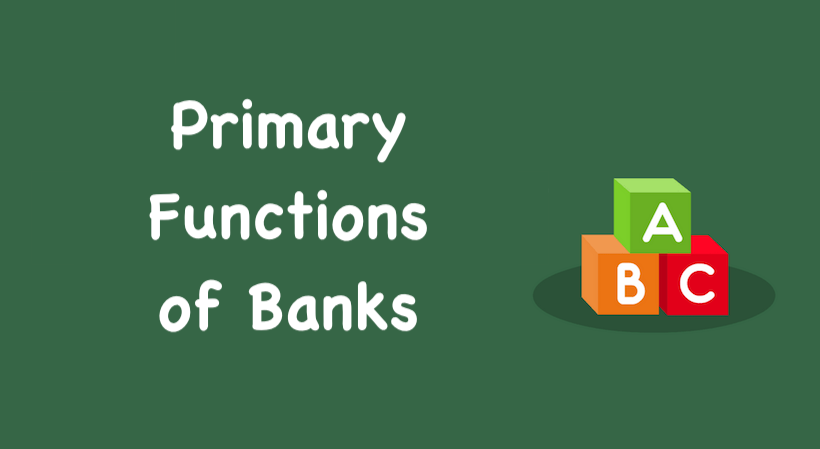Primary Functions of Banks: There are two types of primary functions performed by banks. Banking is the life blood of modern commerce. It has played a very important role in the economic development of all the nations of the world. They are as follows :
Quick Links
Accepting Deposits :
The most important activity of a commercial bank is to mobilize deposits from the public. People who have surplus income and savings find it convenient to deposit the amounts with banks. Depending upon the nature of deposits, funds deposited with a bank also earn interest. Thus, deposits with the bank grow along with the interest earned. If the rate of interest is higher, the public are motivated to deposit more funds with the bank. There is also safety of funds deposited with the bank.
Banks are also called custodians of public money. Basically, the money is accepted as a deposit for safekeeping, but since the banks use this money to earn interest from people who need money, they share a part of this interest with the depositors. The quantum of interest depends upon the tenure – length of time for which the depositor wishes to keep the money with the bank – and the ease of withdrawal. The thumb rule is: the longer the tenure, the higher the rate of interest, and the lesser the restrictions on withdrawal, the lesser the interest.
Granting Loans and Advances :
The second important function of a commercial bank is to grant loans and advances. The banks accept deposit from public for safe-keeping, and pay interest to them. They then lend this money to earn interest on it. In a way, the banks act as intermediaries between the people who have the money to lend and those who need money to carry out business transactions. The difference between the rate of interest paid on deposits and charged on loans is called spread.
The loans and advances are given to members of the public and to the business community at a higher rate of interest than that allowed on various deposit accounts. The rate of interest charged on loans and advances varies according to the purpose and period of loan and the mode of repayment. A loan is granted for a specific time period. Generally, commercial banks provide short – term loans. But they may also grant term loans, i.e. loans for more than a year. A loan may be given in lumpsum or in installments. It is generally granted against the security of certain assets and is normally repaid in installments. However, it may also be repaid in lumpsum.
Overdraft :
This is another method of giving loan or accommodation. The borrower must have account with the bank. He can withdraw in excess of his balance to the extent of the loan limit sanctioned. The excess drawn is treated as loan used and interest is charged accordingly in their accounts. It also pays rent, installments and premium subscriptions as per standing instructions of the customers.
Cash Credit :
A loan account is opened and the borrower can withdraw money up to the sanctioned amount. A promissory note or some tangible security is taken. Interest is charged on the amount of loans actually used. Of course, there is a minimum interest guarantee. The loan is to be repaid on demand. The borrower need not be an account holder of the bank. This method is very popular in India.
The difference between overdraft and cash credit is very subtle and relates to the operation of the account. In the case of cash credit, a proper limit is sanctioned which, normally, is a certain percentage of the value of the commodities/debts pledged by the account holder with the bank.
Overdraft, on the other hand, is allowed against a host of other securities including financial instruments such as shares, units of mutual funds, surrender value of LIC policy, and debentures. Some overdrafts are even granted against the perceived “worth” of an individual. Such overdrafts are called clean overdrafts.
Purchasing and Discounting of Bills :
Discounting of Bills may be another form of bank credit. The bank may purchase inland and foreign bills before these are due for payment by the drawer debtors, at discounted values, i.e., values a little lower than the face values. The Banker’s discount is generally the interest on the full amount for the unexpired period of the bill. The banks reserve the right to debit the accounts of the customers in case the bills are ultimately not paid, i.e., dishonored.
The bill passes to the Banker after endorsement. Discounting of bills by banks provides immediate finance to sellers of goods. This helps them to carry on their business. Banks can discount only genuine commercial bills i.e., those drawn against sale of goods on Credit. Banks will not discount Accommodation Bills.
Lones and Advances :
It includes both demand and term loans, direct loans and advances given to all type of customers mainly to businessmen and investors against personal security or goods of movable or immovable in nature. The loan amount is paid in cash or by credit to customer account which the customer can draw at any time. The interest is charged for the full amount whether he withdraws the money from his account or not.
Short-term loans are granted to meet the working capital requirements where as long-term loans are granted to meet capital expenditure. Previously interest on loan was also regulated by RBI. Currently, banks can determine the rate themselves. Each bank is, however required to fix a minimum rate known as Prime Lending Rate (PLR).
Recommended Articles
- SBI Balance Enquiry Number
- ICICI Balance Enquiry Number
- SBBJ Balance Enquiry Number
- Andhra Bank Balance Enquiry Number
- Karnataka Bank Balance Enquiry Number
- Axis Bank Balance Enquiry Number
- Federal Bank Balance Enquiry
- Union Bank of India Balance Enquiry
- Canara Bank Balance Enquiry Number
- Dena Bank Balance Enquiry Number
- Bank Holidays in India
- Sukanya Samriddhi Yojana







